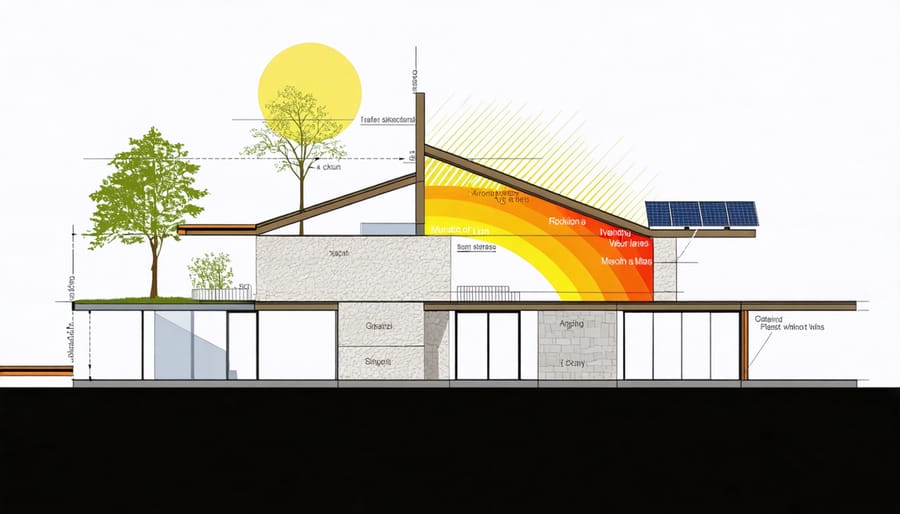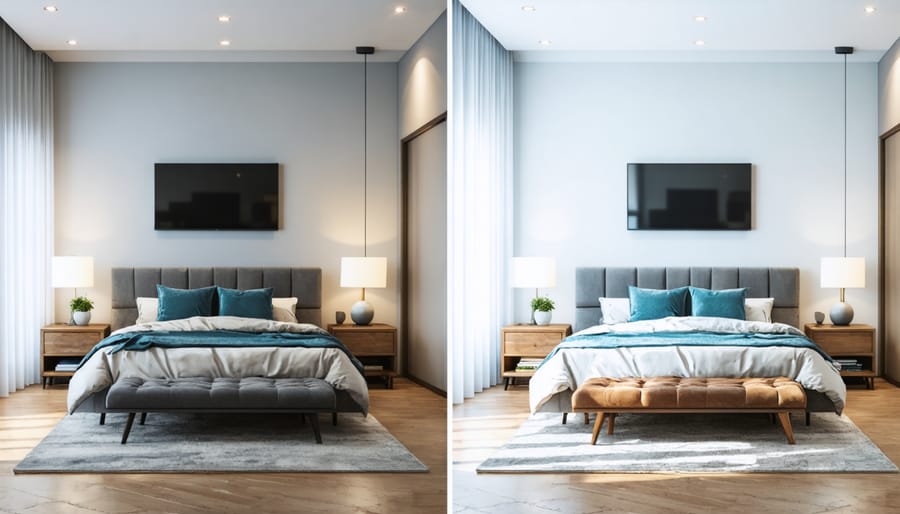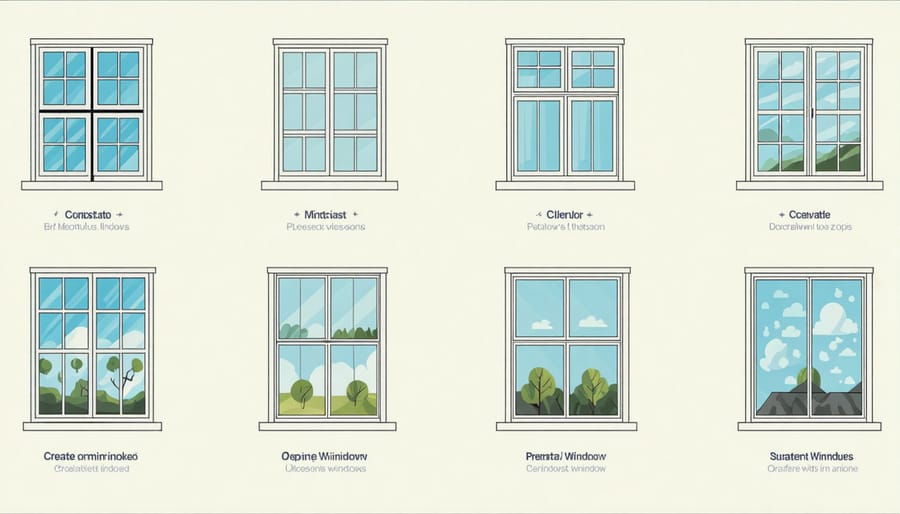Design your home to evolve with changing needs by incorporating flexible room layouts, movable walls, and modular furniture systems that adapt to different life stages. Transform ordinary spaces into multi-functional areas through strategic energy-efficient home design features like adjustable lighting zones and convertible spaces. Create expandable floor plans with pre-planned addition points that allow your home to grow systematically while maintaining structural integrity and aesthetic harmony.
Adaptive house plans represent more than just smart architecture – they’re investments in future-proofed living spaces that respond to environmental challenges, family growth, and lifestyle changes. By integrating resilient materials, universal design principles, and climate-responsive elements, these innovative homes reduce long-term maintenance costs while increasing property value. Whether you’re building new or renovating existing spaces, adaptive design principles ensure your home remains functional, comfortable, and sustainable for decades to come.
What Makes a House Plan Climate-Adaptive?
Passive Design Elements
Smart passive design elements work with nature rather than against it, helping you beat the heat naturally and stay cozy in winter. Natural ventilation is your first ally – strategically placed windows and vents create cooling cross-breezes that reduce the need for air conditioning. Think of it as giving your home its own breathing system!
Solar orientation plays a crucial role too. By positioning your home to maximize winter sun exposure while minimizing summer heat gain, you’ll enjoy natural warmth when you need it and stay cooler when you don’t. South-facing windows (in the Northern hemisphere) are particularly effective for this purpose.
Thermal mass is another clever trick that nature teaches us. Materials like concrete, brick, and stone absorb heat during the day and release it slowly at night, helping maintain comfortable indoor temperatures. It’s like having a natural temperature buffer built right into your walls! Consider incorporating these materials into floors or interior walls where they’ll be most effective.
These passive design elements work together as a system, reducing your energy bills while creating a naturally comfortable living space throughout the year.

Flexible Living Spaces
Imagine a room that serves as your home office during the day, transforms into a guest bedroom at night, and becomes a playroom on weekends. That’s the magic of flexible living spaces! By incorporating multipurpose rooms and adaptable floor plans into your home design, you can maximize every square foot while future-proofing your living space.
Smart furniture choices play a crucial role in creating these versatile spaces. Consider installing murphy beds, fold-down desks, or modular seating that can be easily rearranged. Moveable partition walls and sliding doors allow you to divide or combine spaces as needed, while built-in storage solutions help maintain organization regardless of how the room is being used.
Open floor plans are particularly conducive to flexibility, allowing spaces to flow naturally and adapt to changing needs. Strategic placement of electrical outlets, lighting, and internet connections throughout the room ensures functionality for various purposes. Remember to keep furniture lightweight and mobile, and invest in multi-functional pieces that can serve different roles as your needs evolve.
The key to successful flexible living spaces lies in thoughtful planning and considering how your family’s needs might change over time. Whether you’re accommodating a growing family, working from home, or preparing for aging in place, adaptable spaces provide the versatility modern living demands.

Essential Features of Climate-Smart House Plans
Strategic Window Placement
Strategic window placement can make a significant difference in your home’s comfort and energy efficiency across different climates. In warmer regions, positioning larger windows on the north side (south side for Southern Hemisphere) helps minimize direct sunlight and heat gain during summer months. These windows can be paired with adjustable awnings or overhangs to provide additional control over sunlight exposure.
For colder climates, south-facing windows maximize natural solar heating during winter, helping to reduce heating costs. Consider installing double or triple-pane windows in these locations to prevent heat loss. East and west-facing windows typically receive intense morning and afternoon sun, so keeping them smaller or adding external shading can help manage temperature fluctuations.
In all climates, prioritize cross-ventilation by placing windows on opposite walls when possible. This natural airflow can reduce the need for artificial cooling during moderate weather. For maximum efficiency, aim to have window areas total about 15-18% of your home’s floor space, with proper distribution based on your specific climate zone and seasonal patterns.
Remember to factor in your local landscape as well – existing trees can provide natural shade in summer while allowing winter sun when leaves fall.

Intelligent Insulation Systems
Modern homes deserve insulation that works as intelligently as we do. Adaptive insulation systems represent a breakthrough in how we think about home temperature control, offering dynamic solutions that adjust to changing weather conditions throughout the year. These smart systems utilize phase-change materials and advanced technological innovations to automatically regulate indoor temperatures, making your home more comfortable and energy-efficient.
The key to these systems lies in their ability to react to environmental changes. When temperatures rise, the insulation absorbs excess heat, storing it within specially designed materials. As temperatures drop, this stored heat is released back into your living space, creating a natural heating cycle that reduces energy consumption.
One of the most exciting developments in this field is the integration of sustainable insulation solutions with smart home technology. Sensors embedded within walls can now monitor temperature fluctuations and humidity levels, adjusting the insulation’s performance accordingly. This means your home’s thermal envelope becomes more responsive to both external weather conditions and your personal comfort preferences.
For homeowners looking to implement these systems, options range from aerogel-based materials to dynamic multi-layer solutions that can be installed during construction or as part of a renovation project. The initial investment might be higher than traditional insulation, but the long-term energy savings and improved comfort make it a worthwhile consideration for any adaptive home plan.
Smart Roofing Design
A well-designed roof is your home’s first line of defense against diverse weather conditions. Modern smart roofing incorporates adjustable features that help your home stay comfortable year-round while reducing energy costs. The key is to choose a roof design that works equally well in summer and winter.
Consider implementing a dual-pitch roof system, where steeper sections efficiently shed snow and rain while gentler slopes accommodate solar panels. Light-colored, reflective roofing materials help bounce away harsh summer heat, while proper insulation keeps warmth inside during winter months.
One increasingly popular option is the butterfly roof design, which not only looks striking but also excels at rainwater harvesting and natural ventilation. For areas with heavy snowfall, adding heating elements along roof edges prevents ice dam formation, while extended eaves provide extra shade during hot summers.
Smart venting systems, integrated into your roof design, can automatically adjust airflow based on weather conditions. This helps maintain optimal indoor temperatures while reducing the load on your HVAC system. Remember to include easy access points for maintenance and future modifications – adaptability isn’t just about climate response, but also about practical long-term use.
Versatile Outdoor Spaces
Creating versatile outdoor spaces is essential for maximizing your home’s livability throughout the year. Start by designing covered patios or porches with retractable screens or glass panels that can be adjusted based on weather conditions. These flexible barriers protect against harsh elements while maintaining an open-air feel when desired.
Consider incorporating multi-functional features like built-in seating with storage underneath, or modular furniture that can be easily rearranged. Installing infrared heaters or ceiling fans helps regulate temperature, making the space comfortable in both winter and summer months.
Smart landscaping plays a crucial role too. Plant deciduous trees strategically to provide shade during summer while allowing sunlight through in winter. Add weather-resistant pergolas with adjustable louvers or retractable awnings to control sun exposure and rain protection.
For year-round enjoyment, include proper lighting and electrical outlets for various activities. Consider installing a partial roof system that combines both covered and open sections, giving you the flexibility to enjoy both shade and sunshine. Remember to use weather-resistant materials and proper drainage solutions to ensure your outdoor space remains functional regardless of the season.
Implementing Climate-Adaptive Features in Your Home
Budget-Friendly Adaptations
Creating a climate-adaptive home doesn’t have to break the bank. By focusing on strategic improvements and cost-effective eco-friendly upgrades, you can make meaningful changes while staying within budget.
Start with simple weatherization techniques like adding weatherstripping around doors and windows, which typically costs under $30 per opening. Seal any visible gaps with caulk, and install foam gaskets behind outlet covers to prevent air leakage – these small changes can lead to significant energy savings.
Consider installing removable window films for seasonal adaptation. These affordable solutions (around $20-30 per window) can block heat in summer and retain warmth in winter. For enhanced temperature control, add thermal curtains or cellular shades, which provide excellent insulation at a fraction of the cost of window replacement.
DIY rain gardens are another budget-friendly option, typically costing $100-300 to create. These natural drainage solutions help manage stormwater while adding beauty to your landscape. Pair this with rain barrels ($50-100 each) to collect water for garden use during dry spells.
Paint choices matter too. Light-colored, heat-reflective exterior paint can significantly reduce cooling costs. While slightly more expensive than standard paint, the energy savings quickly offset the initial investment.
For indoor climate control, ceiling fans are a worthy investment at $100-300 per unit. They help circulate air year-round, reducing the load on your HVAC system. Combined with programmable thermostats ($25-50), these improvements can lead to substantial energy savings over time.
Remember, implementing these changes gradually allows you to spread the cost while immediately beginning to enjoy the benefits of a more adaptive home.
Professional vs. DIY Modifications
When it comes to adapting your home, knowing which projects you can tackle yourself and which require professional expertise is crucial for both safety and success. Let’s break it down into clear categories.
DIY-Friendly Modifications:
– Installing grab bars in bathrooms
– Adding lever-style door handles
– Swapping out traditional light switches for rocker switches
– Installing non-slip floor treatments
– Adding pull-out shelves in cabinets
– Mounting ramps for small height differences (under 6 inches)
– Installing motion-sensor lighting
– Adding handrails on existing stairs
Professional-Required Modifications:
– Widening doorways or hallways
– Installing stair lifts or elevators
– Major bathroom renovations (walk-in showers, raised toilets)
– Structural modifications for wheelchair accessibility
– Electrical system upgrades
– Plumbing relocations
– Kitchen remodels involving cabinet height adjustments
– Complex ramp installations
Before starting any DIY project, assess your skill level honestly and consider these key factors:
1. Safety implications of the modification
2. Local building codes and permit requirements
3. Tools and equipment needed
4. Time commitment required
5. Cost comparison between DIY and professional installation
A good rule of thumb: if the modification affects structural elements, electrical systems, plumbing, or requires permits, it’s best to hire a professional. For simple adaptations that don’t impact your home’s core systems, DIY can be a cost-effective approach. When in doubt, consult with a licensed contractor for guidance – it’s better to invest in professional help than risk costly mistakes or safety issues.
Future-Proofing Your Home
When planning an adaptive home, thinking ahead is crucial for both comfort and value. Today’s forward-thinking designs incorporate features that accommodate changing needs while staying ahead of emerging trends in sustainable living.
Start by considering flexible room layouts that can serve multiple purposes throughout your home’s lifetime. A ground-floor study can transform into a bedroom, while open-plan spaces can be easily partitioned when needed. Install adequate electrical outlets and data points throughout to support future tech upgrades and smart home systems.
Universal design principles are becoming increasingly important. Wide doorways, zero-threshold entries, and reinforced bathroom walls for future grab bars aren’t just for accessibility – they’re about creating spaces that work for everyone, at every life stage. Consider installing adjustable-height countertops or designing spaces that can accommodate different mobility needs without major renovations.
Energy efficiency continues to evolve, so plan for future upgrades. Include conduit paths for solar panel wiring, even if you’re not ready to install them yet. Design your roof to accommodate solar panels and consider space for battery storage systems. Smart technology integration points should be incorporated throughout your home to support emerging energy management systems.
Climate resilience is another crucial factor. Design your home with features like elevated foundations in flood-prone areas, impact-resistant windows in storm regions, or passive cooling systems in hot climates. Include space for expanding insulation systems and upgrading ventilation as climate patterns change.
Storage solutions should be adaptable too. Build in modular closet systems that can be reconfigured and include multi-purpose storage areas that can evolve with your needs. Consider incorporating a utility room that can accommodate future appliances or serve as a home automation hub.
Remember, future-proofing isn’t just about technology – it’s about creating spaces that can adapt to changing family dynamics, work patterns, and lifestyle needs while maintaining their functionality and value over time.
Creating a climate-adaptive home isn’t just about preparing for the future – it’s about making smarter choices today that benefit both your lifestyle and the environment. By incorporating features like passive solar design, flexible room layouts, and energy-efficient systems, you’re investing in a home that can withstand changing weather patterns while reducing utility costs. Remember, you don’t have to implement every adaptation at once. Start with the most practical improvements for your climate zone and budget, then gradually expand your home’s adaptive capabilities over time. Whether you’re building new or renovating, every step toward climate adaptation is a step toward a more resilient, comfortable, and sustainable living space. The future of housing is adaptive, and by taking action now, you’re not just protecting your investment – you’re creating a home that will serve you and future generations well for years to come.
